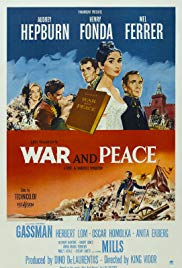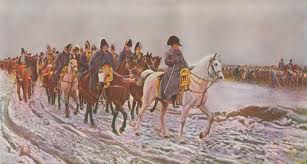WAR AND PEACE
SUBJECTS — World/Russia; Literature/Russia.
AGE: 10+; No MPAA Rating;
Drama; 1956; 208 minutes; Color. Available from Amazon.com.
There is NO AI content on this website. All content on TeachWithMovies.org has been written by human beings.

SUBJECTS — World/Russia; Literature/Russia.
AGE: 10+; No MPAA Rating;
Drama; 1956; 208 minutes; Color. Available from Amazon.com.
TWM offers the following worksheets to keep students’ minds on the movie and direct them to the lessons that can be learned from the film.
Film Study Worksheet for Social Studies Classes for a Work of Historical Fiction and
Worksheet for Cinematic and Theatrical Elements and Their Effects.
Teachers can modify the movie worksheets to fit the needs of each class. See also TWM’s Historical Fiction in Film Cross-Curricular Homework Project.
This film describes the experiences of one Russian aristocratic family during the years 1805 – 1815, the period immediately before and during Napoleon’s invasion of Russia. The movie is based on the classic novel by Leo Tolstoy.
Selected Awards:
1957 Golden Globe Awards: Best Foreign Film; 1956 National Board of Review Awards: Best Foreign Film; 1956 Academy Award Nominations: Best Director (Vidor), Best Color Cinematography, Best Costume Design (Color).
Featured Actors:
Henry Fonda, Audrey Hepburn, Anita Ekberg, Vittorio Gassman, John Mills, Oscar Homolka, Herbert Lom, Helmut Dantine.
Director:
King Vidor.
“War and Peace” provides an introduction to the history of Russia during a crucial period. The movie contains panoramic scenes of battles during the Napoleonic Wars. It ends with the following statement written by Tolstoy:
The most difficult thing — but an essential one — is to love Life, to love it even while one suffers, because Life is all. Life is God, and to love Life is to love God.
MINOR. This story is told from the Russian point of view. At the beginning of the film, Napoleon is referred to as the scourge of Europe. It is true that Napoleon’s ambition led to war, death and destruction throughout most of Europe. However, Napoleon imposed, wherever he conquered, the benefits of the Napoleonic Code, improved educational opportunities, fair administration, etc. The Russian monarchy was reactionary and oppressive. It cared little for its people. The people of Russia resisted Napoleon because he was a foreign invader, not because they loved the Tsar.
See the Helpful Background section. Set a historical background for the film. Tell your child that in modern times there have been two countries that had conquered most of Europe and then tried to invade Russia. The first was France under Napoleon and the second was Germany under Hitler during WWII. On both occasions, the Russians repulsed the invaders. There were several reasons. They include: (1) Russia is very big and the winters are incredibly cold; colder than anything experienced in Germany or France. (2) The Russians in both instances followed a scorched earth policy: cities and villages were burned; factories were moved or destroyed, and stocks of food and grain were moved or burned. There was not enough food to sustain the invading troops. When Napoleon reached Moscow, the capital of Russia, he found that the Russians had burned the city to the ground. (3) The Russians are valiant and determined fighters, especially when defending their homeland. Then ask and help your child to answer the Quick Discussion Question.

War and Peace is a monumental work with 559 separate characters covering ten years of Russian history. The book commemorates important battles and portrays historical personalities. The characterizations are brilliant and the psychological insights keen. It is considered one of the best novels ever written.
Leo Tolstoy (1828 – 1910) was a novelist of immense distinction, his best novels being War and Peace and Anna Karenina. Tolstoy was the son of a nobleman and born to wealth. In the 1880s, when Tolstoy was in his forties he came to castigate himself and other wealthy Russians for leading a dissolute, selfish, and empty existence. He found guides for living in two principals of Christianity: love for all human beings and nonresistance to the forces of evil. These were developed in various works and influenced millions of people, including Mahatma Gandhi, who named his cooperative in South Africa “Tolstoy Farm.” Tolstoy and Gandhi had a friendship through correspondence.
The Napoleonic Code introduced many of the reforms of the French Revolution. It abolished feudalism and serfdom, established freedom of religion (except in Spain), provided for universal male suffrage and enacted a bill of rights. Napoleon also required that the kingdoms he established adopt French-style administrative and judicial systems, foster public education, open higher education to those qualified, regardless of rank, and promote the arts and sciences by establishing academies and subsidizing scientists and artists.
1. See Discussion Questions for Use With any Film that is a Work of Fiction.
2. Was Napoleon a scourge who brought death and destruction or were the benefits of the advances that he brought with him sufficient to justify the Napoleonic Wars? How many countries have been able to overthrow existing repressive regimes without a violent struggle?
3. What other powerful European leader squandered his army in an attempt to invade Russia? Were the factors that caused his invasion to falter the same as those that helped to defeat Napoleon or were they different?
Older children who are excellent readers and who have a lot of stamina should be encouraged to read Tolstoy’s novel War and Peace.
This Learning Guide was last updated on April 10, 2010.